After many days of being at a mooring, it was an extremely nice feeling to be on a moving sailboat. In very good company nonetheless. The wind was blowing from slightly upwind and we got to sail to Powell’s Cay at a good speed. Rob wanted to sail into anchor, which I’ve never done before.
So a bit about Rob. Robert is a welder with a really cool career. He’s good at working with his hands, and is obviously someone very good at teaching himself skills. He has only been cruising and sailing for about a year. But he was sailing his boat that entire year. So instead of a few weekends, he has months and months of sailing experience. Someone’s lifetime of experiences compressed into one year. So he always surprises me with how much he knows about sailing.
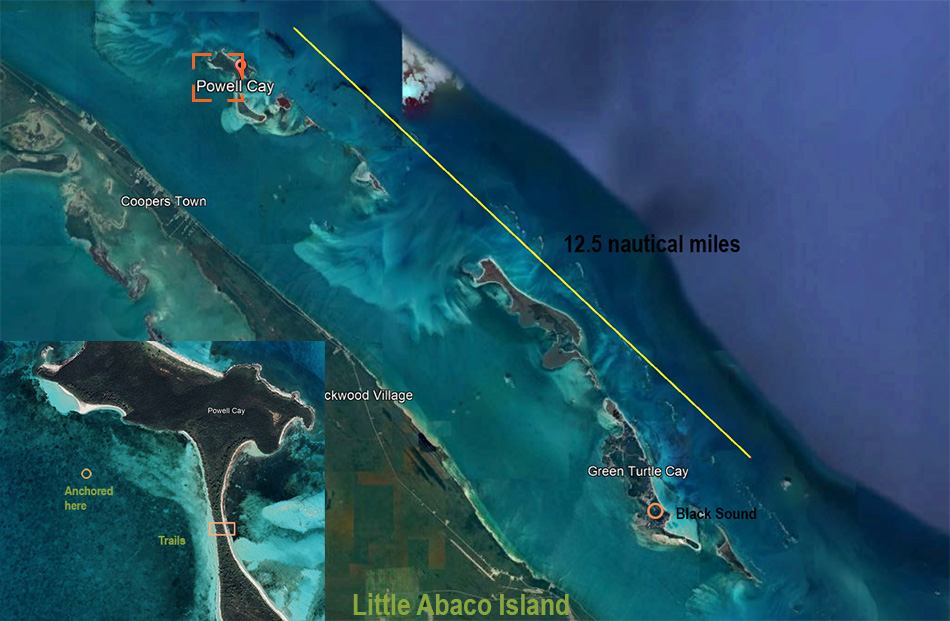
I, on the other hand, have been sailing on and off since 2007 or so. I did a bulk of my learning in Florida and in the Chesapeake Bay, the latter of which is obviously influenced by Annapolis. Interestingly, where you learned to sail seems to greatly influence what you pick up along the way. For Rob, I think it was a lot of cruising skills and the skills you need to fix things that break on your boat. For me, even though I’m mostly a cruiser, was more about learning textbook sailing skills.
He walks me through how to do it. We sail upwind towards the anchor spot. As we get very close, we furl up the headsail. Then as we get even closer, we turn into irons and de-power the main. I let out the mainsheet a tad bit to make this easier. When the boat stops, we lower the anchor until it touches the seabed. When it does, the boat should be drifting backwards a bit. You probably don’t have any steerage at this point, but it is okay. As the rode is payed out and starts getting tension, boat will nose into the wind naturally. At this point, you manually push the mainsail into the wind to back wind the main. This will give you some reverse power to set the anchor. Unfortunately our anchorage was grass on sand, so we needed some engine assistance to get the anchor to really penetrate the sea bad. But it was still really good practice. I wanted to do it a few more times on this cruise, so then I’d be able to tell people I can sail to anchor. It really isn’t that difficult, but it will nonetheless impress a lot of folks. The best kind of sailing skill to show off what a nautical bad ass you are.
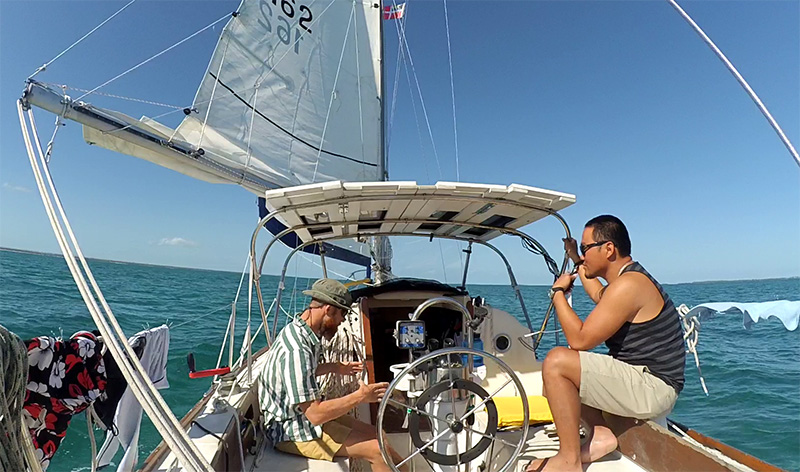
The place we anchored at is beautiful. The land mass surrounds half of the horizon. The colors of the coastline shift. There is an amazing beach in front of us, with vertical coral head cliffs up and down the remainder of the coast. The waters around us are very clear, and you could see both sand and grass all around us. If you look carefully, you can see small fish darting about.
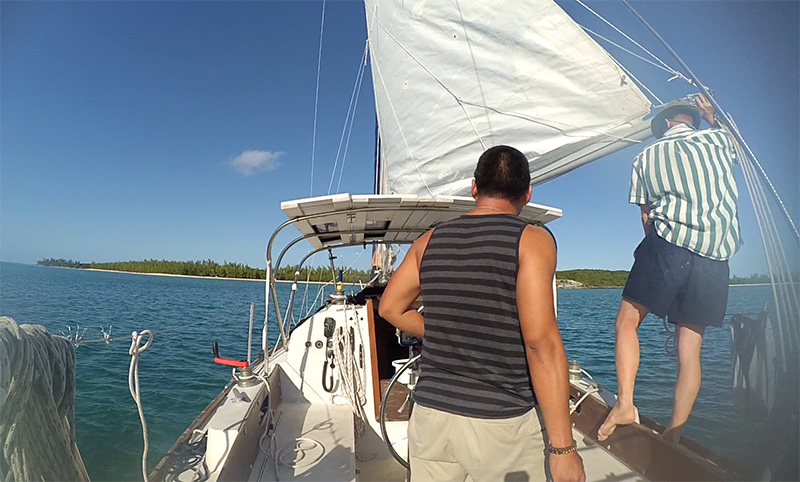
I was antsy to go diving again. We headed out to the outer reefs on Rob’s tender. Looking for reefs can be really interesting. Basically, you find the reef you want to visit on your chart, and head towards it. As you get closer, you try to guess the exact location of the reef. If visibility allows, you try to visually spot where they are. The reefs show up on the water’s surface as patches of very dark brown or black. Then one of us takes a quick dip to see what’s under us. We had a slight onshore conditions that caused the sea bed to churn up a little bit. So on murkier days like this, it’s a bit tricky.
I can’t remember if it was me or Rob who first spotted the reef. But the place was a bit deep and I had to go down and find a spot to anchor. That first jump is always a bit anxiety-producing, but only breaching that barrier will reveal some of the mysteries that lie beneath. I snorkeled around and didn’t see anything but patches of white and brown. I kept swimming in the direction Rob pointed at. At first, I just saw giant brown patch ahead, covering most of my forward vision. Then I could start to make out live coral. I decided to dive a little bit and all of the sudden, I was overloaded with visual inputs.
In front of me were incredible cliffs, ravines, and canyons cut into huge islands of coral. Top of the ‘islands’ were perhaps twelve feet deep, and the bottom of the canyons, covered in sand, must have been an intimidating forty feet or more. When you free-dive past ten meters, the risk of shallow water blackouts increase. As you ascend, oxygen partial pressure decreases past what you need for your brain to function, causing loss of consciousness. In other words, oxygen gets sucked back into your lungs from your blood stream. Hopefully you do not have a snorkel in your mouth and your dive reflex is holding air in your lungs, and your buddy can come save you as you surface.
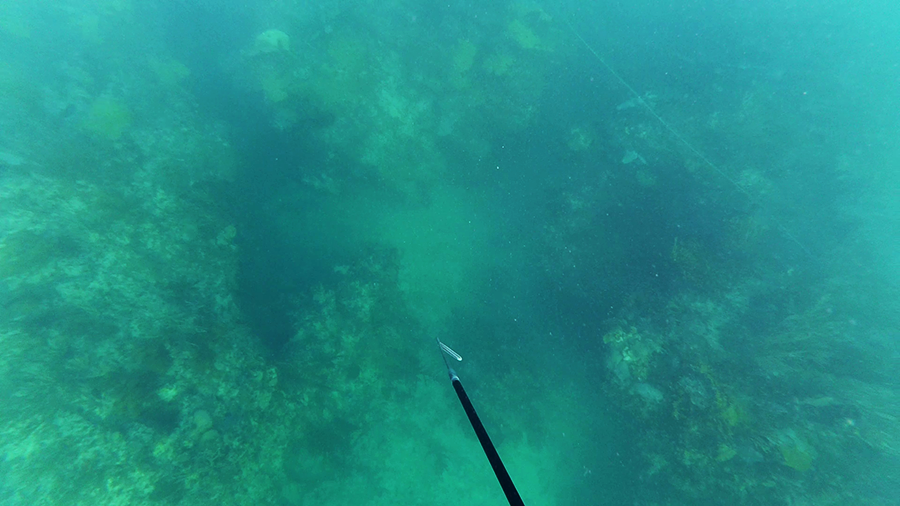
For me, this risk is a bit low. I am a very new freediver and I’ll come up pretty quickly once I start convulsing. I don’t think I ever want to find my limit under water. I know I can do a two minute breath hold on my couch, and can hold my breath for ninety seconds if I’m walking. So underwater, I try to stay under a minute. I also try hard not to hyperventilate, which can cause you to overestimate how long you have left.
I found a sandy patch on top of one of those reefs islands. I swam back to the tender and grabbed the six pound anchor and chain. I swam it back to the patch. I set the anchor into the patch, with one of the claws wedged against hard coral. We had a lot of rode out and the anchor held, and the rode didn’t touch any of the live coral around the sandy patch.
The rest of the dive session was the highlight of my trip so far. The further I dove, the more amazing the sights. I was too scared to get into some of the smaller ravines. But I would get to some of the large sandy patches at the bottom.
The fish here moved around with a mission. At times schools of fish swam all around me, changing direction the last minute to avoid colliding into me. It made me wonder if there was a shark chasing them around. In one dive, as I was slowly descending, a couple of large reef fish, hovering vertically along the cliffs took notice . They hovered in place, changing their orientation to keep themselves aimed at me. I think they were being cautious, but they also looked curious. I enjoyed that little interaction.
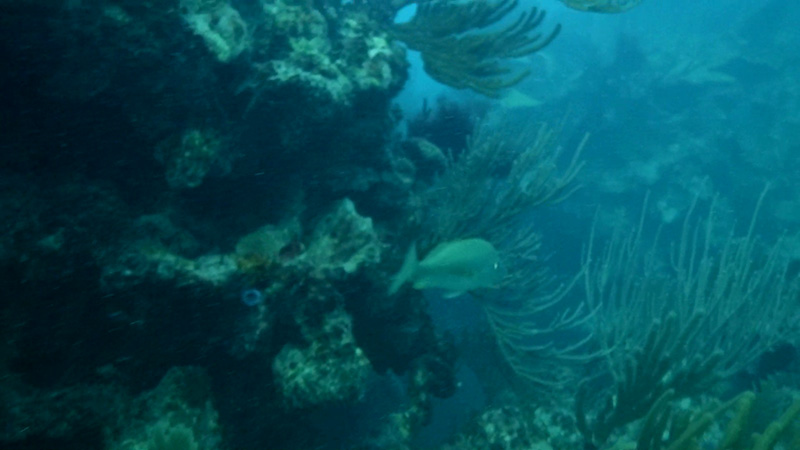
I went down to about ten feet glided across the tops of the coral islands. In a deep ravine, I saw a huge orange fish. Maybe five feet long. Too big to spear for my comfort, too deep and far out of reach. I only saw it for a few seconds but I was happy to admire it from a distance. Later on, as we floated on the surface, me and rob saw a huge stingray at the sea bed. It was relaxing like it had nothing to worry about. Much bigger than the one we saw at our last dive. Perhaps six or seven feet across. Its large eyes looked up at us as we swam over it.
I dove down to the sea bed and inverted so I could get my feet on the sand. I left the cloud of bubbles behind and got closer and closer to the sandy patch beneath me. I tried to avoid looking up. I find the sight of the ‘distant’ surface a bit intimidating and it usually causes me to surface. Near the bottom, I rotated and got my legs under me. As soon as my fee touched the sand, something changed.
I am not scuba diving, so there weren’t any bubbles coming off of me. Air bubbles tend to scare fish away. Now that I was stationary, the fish around me started to ignore me and life in the reef went on as usual. I stared at the walls surrounding me, holes and spires of coral rock all round, teeming with life. It seemed to stretch up and up, as if it touched the surface. The sun put on a show, light dancing around and highlighting the different colors of the reef. For a little while, I was part of the landscape. It was truly a special experience, where me, a clumsy land creature, joined this underwater city for a few precious moments.
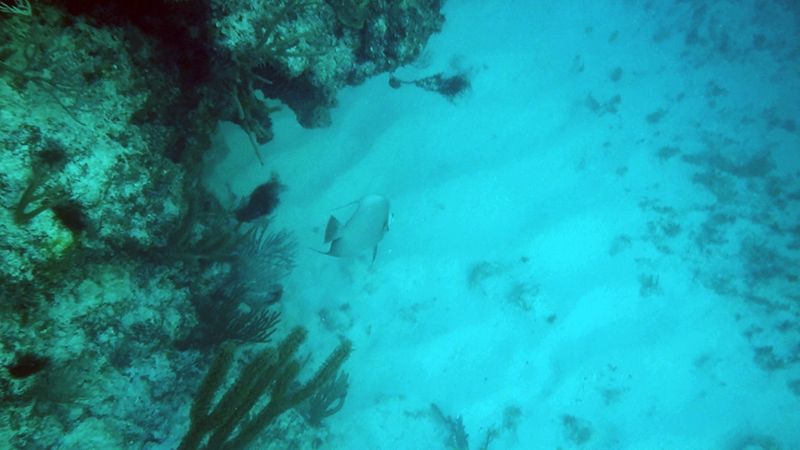
When I was done sightseeing, I took a few shots at some fish. In a spire of coral between two larger reefs, a school of yellow fin jack were swimming about. I spotted one big enough to be a meal and dove down after it. Though it was probably in reach, it was too fast. I chased after it. We did a few laps around the spire on a merry-go-round chase, like Tom and Jerry, before I had to surface. Of course, I was Tom, clumsy and unsuited for aquatic life.
The way fish moved about started to make sense to me. Some schools of fish seemed to do laps around the reef, returning to the same spot in their mad race around the circuit. Others schooled over just to check me out. Very cool. These reef fish are much smarter than us land-dwellers give them credit for. It makes sense. They have to survive in a very bio-dense environment. Much thanks to this adaptation, we had no luck taking any game. We even spotted a few lobsters, but they were deep and far out of reach.
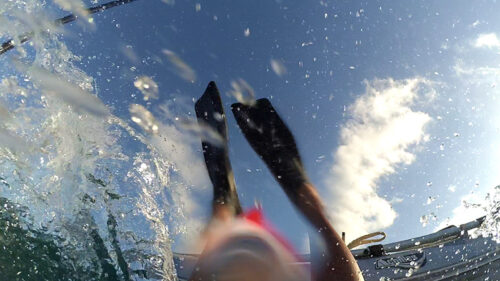
This dive was definitely the highlight of my stay in Green Turtle Cay. The next day was the last day before Alec had to leave. We tried to return to the same reefs but the onshore conditions were too strong. I did some scouting dives from the dinghy and the visibility was very poor, as the water had been churned up by the waves. I could hardly see the sea bed. When I dove down for a better visibility, I could not see the bottom. It should have been more terrifying than it was — I am not sure how my brain processes this type of fear, but I was fairly calm.
At some point, I found an underwater ledge peeking into my vision midst all the sediment. Lobster hang out there. But when I came back up to take a breath, I could not find the ledge again. We gave up on taking any sea-game and decided to spend some time at the lee shore of Powell Cay, where it was calm. Rob climbed a cliff, and I saw an owl fly away, probably scared of Rob. I also got to swim around a wreck of a ship nearby at the anchorage. Since it was the only structure on that bay of grass, the fish had all gathered there. Too bad it was too close to shore, as there were a few fish that I could have speared. I still enjoyed admiring them. Later, while trying to find a path across the island, Alec and Rob spent a good amount of time and effort blazing a trail through the tick vegetation. I waited by the dinghy. Hilariously, turns out that there was a trail a few dozen yards north of the newly created trail. Rob and Alec said they enjoyed bushwhacking anyways. Apparently Alec did a bulk of the work — in a display of his innovative abilities, he took a milk crate, stood on it, and started stomping out a trail by jumping up an downs. Unfortunately, when they did reach the other side, they did not find any suitable beach for us to swim off of. It was just gross mud everywhere.
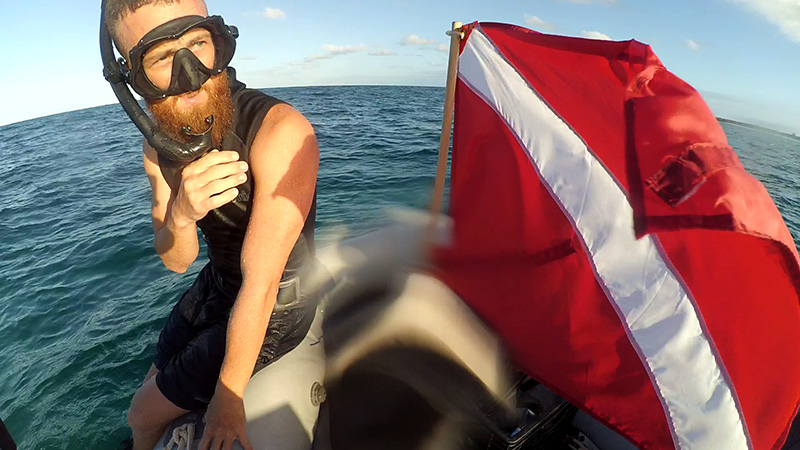
So, we accomplished nothing but there was nothing wrong with that. We got to see some amazing sights and spent two days at a beautiful anchorage off of an uninhabited island. What a life.
Every night during our stay in Green Turtle Cay, we went into town to get food and drinks. Food tastes so much better after a long day of water activities. We were cheap dates all those nights. Living on the water gets you drunk with so much less. We’d walk slowly back to the docks, talking about whatever that came to mind, then dinghy back to Sonora to sleep. Except this night was different – it was Alec’s last night on the island. I think we drank just a bit more than usual. We were both too tired to really talk about the departure, but the feelings were in the air.
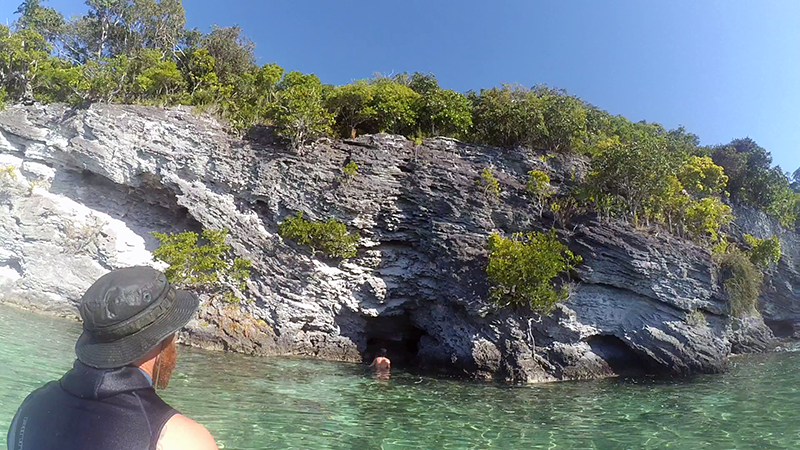
Everything from Alec’s booking of the flight, pre-flight COVID-19 test and finding a ride to the airport went off without a hitch. A neighbor at the dock was going into town, and Alec was able to hitch a ride with him – a ferry ride as well as a car ride. I woke up early in the morning saw Alec off to the entrance to Donny’s marina. And just like that in that groggy, dark morning, I was a single hander again.
I don’t know if I’ve ever talked about this. Back in law school, I helped start a kickboxing team for the university. Alec was the second kickboxing student I ever helped train. I was at his corner at his first kickboxing match. Even though I was only twenty four or so and he’d have been eighteen, I could tell Alec had fire in his heart with guts to match. We didn’t see any harsh conditions the whole time he was here, but I had no doubt he’d perform if we had run into bad weather. And he stepped up every chance he got and learned everything quickly. Its really nice to have crew like that, but I also found the thirty year old Alec to be really interesting. He has a lot of thoughts behind his pseudo-artist presentation. I’ll miss him. I hope not another decade goes by before I see him again.
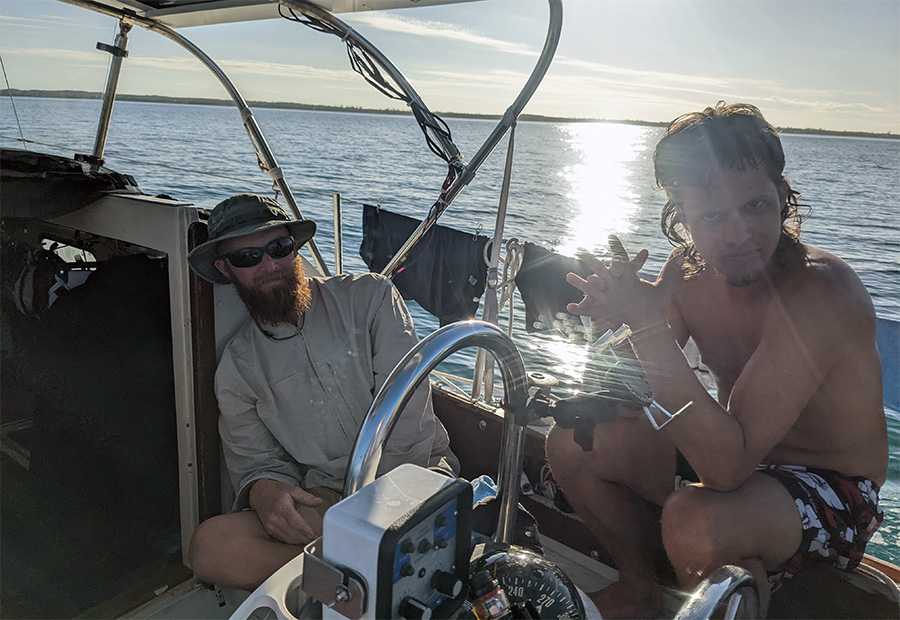
After Alec left, I stayed another day at Green Turtle Cay. I lazily ran my errands on the second to last day, filling up Sonora’s water tanks and getting fuel. Wind was picking up a bit and the waters inside the harbour got a bit choppy. In the middle of my dinghy ride to the only fuel dock on Black Sound, I realized that I had left the dinghy fuel jug on Sonora. I opened the cap and peeked inside the internal tank. There was barely any fuel left. On a wing and a prayer, I made what I thought was the most fuel efficient speed to the fuel docks, since it was closer than Sonora. The engine ran out of fuel and sputtered off just as I reached out to grab the dock’s ladders! That was the last errand to run, and I was ready to leave.
I had spent a whole week at Green Turtle Cay and made a new friend. What an interesting island. It was basically made up of locals, resort vacationers, and cruisers, and folks who work in industries related to the visitors. A unique world of two parts, where the visitors were not merely modifiers, but a component of that world, while the locals were truly people who had been there for generations. But I was antsy to see the rest of the Abacos. Next stop would be Man-O-War Cay.
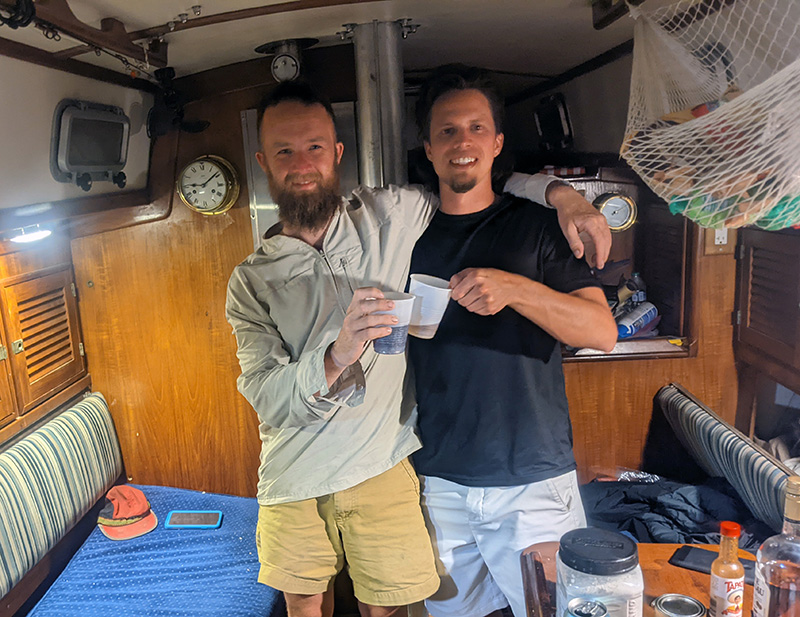
Mainsheet: the line that control the boom and mainsail. The primary way of controlling the mainsail.
Back-wind: back-winding happens when the sail is still on the windward side of the boat, receiving wind from the wrong side. This creates reverse thrust, which slows down or even backs down a sailboat. On Sonora, this is accomplished by either screwing up a tack, or intentionally by pushing the boom over to the windward side by hand.